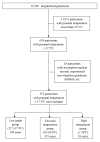Retrospective study of intrapartum fever in term pregnancies and adverse obstetric and neonatal outcomes
- PMID: 36320562
- PMCID: PMC9618262
- DOI: 10.7717/peerj.14242
Retrospective study of intrapartum fever in term pregnancies and adverse obstetric and neonatal outcomes
Abstract
Background: Intrapartum fever is a well-known predisposing factor for severe perinatal outcomes. Herein, we explored the intrapartum features, obstetric outcomes, and neonatal outcomes in relation to the extent of intrapartum fever via three group analyses.
Methods: A retrospective cohort analysis consisting of 575 term, singleton live births in one medical center from January 1st to December 31st, 2020 was carried out. Parturients who had experienced a maximal intrapartum fever of <38.0 °C were compared with two sub-groups of parturients who had experienced respective maximal fevers of 38.0-38.9 °C and ≥39.0 °C. We computed the adjusted risks for adverse perinatal outcomes via multiple logistic regression models to control for confounders.
Results: There were statistically remarkable differences among the three groups in 13 items including body mass index, epidural, and WBC before delivery (p < 0.05). In contrast with intrapartum fevers of 37.5-37.9 °C, intrapartum fevers of 38.0-38.9 °C were linked to an elevated risk of neonatal sepsis and neonatal intensive care unit admission with an odds ratio (OR) of 4.28 (95% CI 2.162-8.479) and 1.73 (95% CI 1.125-2.666), nonetheless, the relationship was remarkably higher for intrapartum fever ≥39.0 °C, with an OR of 6.40 (95% CI 2.450-16.725) and 2.23 (95% CI 1.021-4.854). Additionally, intrapartum fevers of 38.0-38.9 °C and ≥39.0 °C were related to remarkably higher risk for operative deliveries (OR 2.24, 95% CI 1.373-3.648; OR 3.59, 95% CI 1.398-9.226; respectively) and histological chorioamnionitis (OR 3.77, 95% CI 2.261-6.271; OR 19.24, 95% CI 7.385-50.111, respectively).
Conclusions: Intrapartum fever is an important indicator of adverse perinatal outcomes. The higher the temperature, the higher risk of histological chorioamnionitis, as well as the risk of neonatal sepsis and neonatal intensive care unit admission.
Keywords: Adverse neonatal outcomes; Cesarean delivery; Histological chorioamnionitis; Intrapartum fever; Term pregnancy.
©2022 An et al.
Conflict of interest statement
The authors declare there are no competing interests.
Figures
Similar articles
-
Very High Intrapartum Fever in Term Pregnancies and Adverse Obstetric and Neonatal Outcomes.Neonatology. 2016;109(1):62-8. doi: 10.1159/000440938. Epub 2015 Nov 5. Neonatology. 2016. PMID: 26536344
-
Antibiotic treatment of women with isolated intrapartum fever vs clinical chorioamnionitis: maternal and neonatal outcomes.Am J Obstet Gynecol. 2023 Nov;229(5):540.e1-540.e9. doi: 10.1016/j.ajog.2023.05.013. Epub 2023 Jul 4. Am J Obstet Gynecol. 2023. PMID: 38051599
-
The association of maternal intrapartum subfebrile temperature and adverse obstetric and neonatal outcomes.Paediatr Perinat Epidemiol. 2014 Jan;28(1):39-47. doi: 10.1111/ppe.12090. Epub 2013 Oct 10. Paediatr Perinat Epidemiol. 2014. PMID: 24118104
-
Maternal fever in labor: etiologies, consequences, and clinical management.Am J Obstet Gynecol. 2023 May;228(5S):S1274-S1282. doi: 10.1016/j.ajog.2022.11.002. Epub 2023 Mar 20. Am J Obstet Gynecol. 2023. PMID: 36997396 Review.
-
Determining the optimal antibiotic regimen for chorioamnionitis: A systematic review and meta-analysis.Acta Obstet Gynecol Scand. 2021 May;100(5):818-831. doi: 10.1111/aogs.14044. Epub 2021 Jan 16. Acta Obstet Gynecol Scand. 2021. PMID: 33191493
Cited by
-
Maternal bacteremia in intrapartum fever: the role of ampicillin resistance and prolonged membrane rupture-a retrospective comparative study.Arch Gynecol Obstet. 2025 Aug;312(2):451-460. doi: 10.1007/s00404-025-08030-6. Epub 2025 Apr 23. Arch Gynecol Obstet. 2025. PMID: 40266333 Free PMC article.
-
Development and validation of a prediction model for intrapartum fever related to chorioamnionitis in parturients undergoing epidural analgesia.Sci Rep. 2024 Dec 28;14(1):31298. doi: 10.1038/s41598-024-82722-y. Sci Rep. 2024. PMID: 39732828 Free PMC article.
-
Duration time of labor progression for pregnant women of vaginal birth after cesarean in Hubei, China.Ir J Med Sci. 2024 Jun;193(3):1351-1358. doi: 10.1007/s11845-023-03600-6. Epub 2024 Jan 2. Ir J Med Sci. 2024. PMID: 38169049
-
Construction of a nomogram model for predicting infectious intrapartum fever.Zhejiang Da Xue Xue Bao Yi Xue Ban. 2023 Feb 25;52(1):54-60. doi: 10.3724/zdxbyxb-2022-0479. Zhejiang Da Xue Xue Bao Yi Xue Ban. 2023. PMID: 37283118 Free PMC article. Chinese, English.
References
-
- Abramov Y, Ezra Y, Elchalal U, Ben-Shachar I, Fasouliotis SJ, Barak V. Markedly elevated levels of inflammatory cytokines in maternal serum and peritoneal washing during arrested labor. Acta Obstetricia et Gynecologica Scandinavica. 2004;83:358–363. doi: 10.1111/j.0001-6349.2004.00271.x. - DOI - PubMed
-
- Carlo WA, McDonald SA, Tyson JE, Stoll BJ, Ehrenkranz RA, Shankaran S, Goldberg RN, Das A, Schendel D, Thorsen P, Skogstrand K, Hougaard DM, Oh W, Laptook AR, Duara S, Fanaroff AA, Donovan EF, Korones SB, Stevenson DK, Papile LA, Finer NN, O’Shea TM, Poindexter BB, Wright LL, Ambalavanan N, Higgins RD, Eunice Kennedy Shriver National Institute of Child Health and Human Development Neonatal Research Network Cytokines and neurodevelopmental outcomes in extremely low birth weight infants. The Journal of Pediatrics. 2011;159:919–925.e3. doi: 10.1016/j.jpeds.2011.05.042. - DOI - PMC - PubMed
Publication types
MeSH terms
LinkOut - more resources
Full Text Sources


